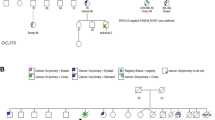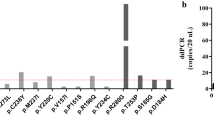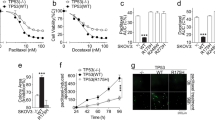Abstract
Changes in cell survival contribute to tumour development, influence tumour biology and its response to chemotherapy. p53 gene alterations should negatively affect apoptosis by impaired p53-dependent apoptotic response. We looked for associations between spontaneous apoptosis, p53 gene mutation, p53 protein accumulation, growth fraction, bcl-2 expression and histological parameters in 64 ovarian, four tubal and three peritoneal carcinomas. Apoptotic cells were detected with the TUNEL method. p53 gene variants were detected by the single-strand conformation polymorphism and were sequenced directly. P53, Ki-67 and bcl-2 protein expressions were detected immunohistochemically. A weighed multiple logistic regression model was applied. Apoptotic index (Al) ranged 0.02–0.18 (mean 0.11); proliferation index (PI) ranged 3–90% (mean 54%). p53 gene mutations were present in 51, p53 protein accumulation in 46, and diffuse bcl-2 expression in 29 of 71 tumours. The AI was positively associated with the presence of p53 gene mutation (P = 0.011). However, the PI included into the analysis did positively influence the AI (P = 0.02) and diminished the association with p53 gene mutation (P = 0.082). The AI was negatively associated with good histological differentiation (P = 0.0006), the serous tumour type (P = 0.002), and diffuse bcl-2 expression (P = 0.025). Strong bcl-2 expression was associated with endometrioid tumour type (P = 0.002). FIGO stage and p53 protein accumulation were the only parameters that influenced overall survival time. Thus, our results suggest that histological tumour type and grade are major determinants of spontaneous apoptosis in ovarian carcinomas; p53 alterations do not adversely but rather positively affect spontaneous apoptosis by increasing growth fraction. This, in turn, suggests p53-independency of spontaneous apoptosis in ovarian carcinomas. © 2000 Cancer Research Campaign
Similar content being viewed by others
Article PDF
Change history
16 November 2011
This paper was modified 12 months after initial publication to switch to Creative Commons licence terms, as noted at publication
References
Amundson SA, Myers TG and Fornace AJ (1998) Roles for p53 in growth arrest and apoptosis: putting on the breaks after genotoxic stress. Oncogene 17: 3287–3299
Barber RH, Sommers SC, Snyder R and Kwon TH (1975) Histologic and nuclear grading and stromal reactions as indices for prognosis in ovarian cancer. Am J Obstet Gynecol 15: 795–804
Bellamy COC (1996) p53 and apoptosis. Br Med Bull 53: 522–538
Creasman WJ (1989) Announcement, FIGO stages 1988, Revisions. Gynecol Oncol 35: 125–127
de Feudis P, Debernardis D, Beccaglia P, Valenti M, Graniela Sire E, Arzani D, Stanzione S, Parodi S, D'Incalci M, Russo P and Broggini M (1997) DDP-induced cytotoxicity is not influenced by p53 in nine human ovarian cancer cell lines with different p53 status. Br J Cancer 76: 474–479
de Stanchina E, McCurrach ME, Zindy F, Shieh SY, Ferbeyre G, Samuelson AV, Prives C, Roussel MF, Sherr CJ and Lowe SW (1998) E1A signaling to p53 involves the p19 (ARF) tumor suppressor. Genes Dev 12: 2434–2442
Diebold J, Baretton G, Felchner M, Meier W, Dopfer K, Schmidt M and Lohrs U (1996) bcl -2 expression, p53 accumulation, and apoptosis in ovarian carcinomas. Am J Clin Pathol 105: 341–349
Evan G and Littlewood T (1998) Apoptosis. A matter of life and cell death. Science 281: 1317–1322
Goodman LA and Kruskal WH (1979). Measures of Association for Cross Classifications. Springer-Verlag: New York
Henriksen R, Strang P, Wilander E, Backstrom T, Tribukait B and Oberg K (1994) P53 expression in epithelial ovarian neoplasms: relationship to clinical and pathological parameters, Ki-67 expression and flow cytometry. Gynecol Oncol 53: 301–306
Herod JJO, Eliopoulos AG, Warwick J, Niedobitek G, Young LS and Kerr DJ (1996) The prognostic significance of bcl-2 and p53 expression in ovarian carcinoma. Cancer Res 56: 2178–2184
Hirai Y, Kaku S, Teshimi H, Shimuzu Y, Chen JT, Hamada T, Fujimoto I, Yamauchi K, Sakamoto A, Hasumi K and Masubuchi K (1989) Carcinoma of the fallopian tube. Experience with 15 cases. Gynecol Oncol 34: 20–26
Klemi PJ, Pylkkanen L, Kiilholma P, Kurvinen K and Joensuu H (1995) p53 protein detected by immunohistochemistry as a prognostic factor in patients with epithelial ovarian carcinoma. Cancer 76: 1201–1208
Kupryjanczyk J (1996) [ p53 gene mutations and p53 protein accumulation in ovarian cancer – a review]. Nowotwory 46: 35–66
Kupryjanczyk J, Thor AD, Beauchamp R, Merritt V, Edgerton S, Bell DA and Yandell DW (1993) P 53gene mutations and protein accumulation in human ovarian cancer. Proc Natl Acad Sci USA 90: 4961–4965
Kupryjanczyk J, Bell DA, Dimeo D, Beauchamp R, Thor AD and Yandell DW (1995 a) p53 gene analysis of ovarian borderline tumors and stage I carcinomas. Hum Pathol 26: 387–392
Kupryjanczyk J, Edgerton S, Effird J, Yandell DW and Thor AD (1995 b) S phase fraction in gynecologic cancers. A comparison with p53 accumulation and p53 gene mutation. Path Res Pract 191: 705
Liebermann DA, Hoffman B and Steinman RA (1995) Molecular controls of growth arrest and apoptosis: p53-dependent and independent pathways. Oncogene 11: 199–210
Lowe SW, Ruley HE, Jacks T and Housman D (1993) p53-dependent apoptosis modulates the cytotoxicity of anticancer agents. Cell 74: 957–967
McMenamin ME, O'Neil AJ and Gaffney EF (1997) Extent of apoptosis in ovarian serous carcinoma: relation to mitotic and proliferative indices, p53 expression, and survival. Mol Path 50: 242–246
Mehta CR and Patel NR (1983) A network algorithm for the exact treatment of Fisher's Exact Test in R × C Contingency Tables. J Am Stat Assn 78: 427–434
Miyashita T and Reed JC (1995) Tumor suppressor p53 is a direct transcriptional activator of the human bax gene. Cell 80: 293–299
Miyashita T, Harigai M, Hanada M and Reed JC (1994 a) Identification of a p53-dependent negative response in the bcl-2 gene. Cancer Res 54: 3131–3135
Miyashita T, Krajewski S, Krajewska M, Wang HG, Lin HK, Liebermann DA, Hoffman B and Reed JC (1994 b) Tumor suppressor p53 is a regulator of bcl -2 and bax gene expression in vitro and in vivo. Oncogene 9: 1799–1805
Peterson F, Kolstad P, Ludwig H and Ulfelder H (1988) Annual Report on the Results of Treatment in Gynecological Cancer. Vol. 20. International Federation of Gynecology and Obstetrics: Stockholm
Qin XQ, Livingston DM, Kaelin WG Jr and Adams PD (1994) Deregulated transcription factor E2F-1 expression leads to S-phase entry and p53-mediated apoptosis. Proc Natl Acad Sci USA 91: 10918–10922
Reed JC (1997) Double identity for proteins of the Bcl-2 family. Nature 387: 773–776
Righetti SC, Della Torre G, Pilotti S, Menard S, Ottone F, Colnaghi MI, Pierotti MA, Lavarino C, Cornarotti M, Oriana S, Bohm S, Bresciani GL, Spatti G and Zunino F (1996) A comparative study of p53 gene mutations, protein accumulation, and response to cisplatin-based chemotherapy in advanced ovarian carcinoma. Cancer Res 56: 689–693
Rohlke P, Milde-Langosch K, Weyland C, Pichlmeier U, Jonat W and Loning T (1997) p53 is a persistent and predictive marker in advanced ovarian carcinomas: multivariate analysis including comparison with Ki-67 immunoreactivity. J Cancer Res Clin Oncol 123: 496–501
Russell P (1994) Surface epithelial-stromal tumors of the ovary. In: Blausteins Pathology of the Female Genital Tract, Kurman RJ (ed), pp. 705–782. Springer-Verlag: Berlin
Siegel S and Castellan NJ (1988). Non-parametric Statistics for the Behavioral Sciences, 2nd edn. McGraw UK: New York
Tai YT, Lee S, Niloff E, Weisman C, Strobel T and Cannistra SA (1998) BAX protein expression and clinical outcome in epithelial ovarian cancer. J Clin Oncol 16: 2583–2590
Wagner AJ, Kokontis JM and Hay N (1994) Myc-mediated apoptosis requires wild-type p53 in a manner independent of cell cycle arrest and the ability of p53 to induce p21waf1/cip1. Genes Dev 8: 2817–2830
Williams DA (1982) Extra-binomial variation in logistic linear models. Applied Statistics 31: 144–148
Wu X and Levine AJ (1994) p53 and E2F-1 cooperate to mediate apoptosis. Proc Natl Acad Sci USA 91: 3602–3606
Yamasaki F, Tokunaga O and Sugimori H (1997) Apoptotic index in ovarian carcinoma: correlation with clinicopathologic factors and prognosis. Gynecol Oncol 66: 439–448
Yonish-Rouach E, Grunwald D, Wilder S, Kimchi A, May E, Lawrence J-J, May P and Oren M (1993) p53-mediated cell death: relationship to cell cycle control. Mol Cell Biol 13: 1415–1423
Zindy F, Eischen CM, Randle DH, Kamijo T, Cleveland JL, Sherr CJ and Roussel MF (1998) Myc signaling via the ARF tumor suppressor regulates p53-dependent apoptosis and immortalization. Genes Dev 12: 2424–2433
Author information
Authors and Affiliations
Rights and permissions
From twelve months after its original publication, this work is licensed under the Creative Commons Attribution-NonCommercial-Share Alike 3.0 Unported License. To view a copy of this license, visit http://creativecommons.org/licenses/by-nc-sa/3.0/
About this article
Cite this article
Kupryjańczyk, J., Dansonka-Mieszkowska, A., Szymańska, T. et al. Spontaneous apoptosis in ovarian carcinomas: a positive association with p53 gene mutation is dependent on growth fraction. Br J Cancer 82, 579–583 (2000). https://doi.org/10.1054/bjoc.1999.0967
Received:
Revised:
Accepted:
Published:
Issue date:
DOI: https://doi.org/10.1054/bjoc.1999.0967
Keywords
This article is cited by
-
Spontaneous regression in recurrent epithelial ovarian cancer
Archives of Gynecology and Obstetrics (2007)
-
TP53 status determines clinical significance of ERBB2 expression in ovarian cancer
British Journal of Cancer (2004)
-
Evaluation of clinical significance of TP53, BCL-2, BAX and MEK1 expression in 229 ovarian carcinomas treated with platinum-based regimen
British Journal of Cancer (2003)



